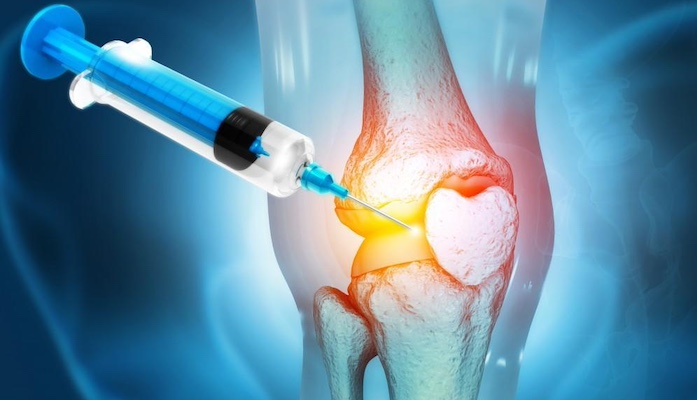
Knee osteoarthritis
Symptomatic knee osteoarthritis (OA) is a leading cause of disability globally with a significant financial impact. The development of knee OA involves the cartilage and the entire joint, with changes in the articular bone, synovial membrane, joint capsule, ligaments, and musculature around the joint.
There is no disease-modifying therapy for the management of OA; therefore, the treatment goals are to improve pain and function. Pharmacotherapy management includes topical and oral nonsteroidal anti-inflammatory drugs, duloxetine, and periodic intra-articular glucocorticoid and hyaluronan injections.
PRP-containing growth factors stimulate local angiogenesis, regulate inflammation, inhibit catabolic enzymes and cytokines, and recruit local stem cells and fibroblasts to the damaged sites. PRP also induces nearby healthy cells to synthesize greater growth factors and increase endogenous hyaluronan synthesis with few serious side effects. In recent years, PRP has emerged as a viable treatment method for the management of knee OA. Eighteen studies (all level 1) involving 811 patients undergoing intra-articular PRP injection (mean age, 57.6 years) and 797 patients undergoing hyaluronic acid injection (mean age, 59.3 years) showed that the mean improvement in Western Ontario and McMaster Universities Osteoarthritis Index (WOMAC) total scores was significantly higher in the PRP group (44.7%) than in the hyaluronic acid group (12.6%) (p<0.01).
Many systematic reviews and meta-analyses have found positive results for PRP in relieving pain and improving function in knee OA. Therefore, PRP can be expected to improve pain and function in managing knee OA, although further studies are needed for the definitive assessment of knee OA treatment.
Ankle joint osteoarthritis
Ankle OA is rarer than OA of the hip and knee and is more common in young active individuals, with a prevalence of 3.4% in the general adult population. The primary etiology of ankle OA is trauma, and the overall risk of developing posttraumatic ankle OA after 20 years is almost 40%. The management of ankle OA involves nonsurgical options (medications, physical therapy, orthotics, and insoles, and intra-articular injections) and surgical options (joint-sparing surgery, total ankle arthroplasty, and ankle arthrodesis).
Individuals with ankle OA, hemophilic arthropathy, and rheumatoid arthritis were included in 27 studies (1,085 patients). Most of these studies were observational. A case series found that PRP, MSC, hyaluronic acid and corticosteroid injections provided symptomatic relief, although the efficacy of corticosteroid injections was short-term.
PRP injections for ankle OA are valid and safe alternatives for postponing the need for surgery. PRP injections are favored for the treatment of pain associated with ankle OA. However, the relative efficacy of PRP injection therapy is far from definitive and warrants further high-quality comparative trials.
Temporomandibular joint osteoarthritis
The prevalence of temporomandibular (TM) joint OA is increasing, and it is more common in women. OA may cause pain in the TM joint area. Excessive or prolonged overload of TM joints may lead to adverse remodeling, resulting in OA. The management of TM OA includes conservative treatment (medications, splints, and physiotherapy), intra-articular injections, arthrocentesis, arthroscopy, and open-joint surgery.
A comparative randomized study showed that maximum improvements in pain-free mouth opening and reduction in pain severity were observed in all groups (bite splint, betamethasone, sodium hyaluronate, and PRP injections in addition to using the bite splint). In the PRP group, patients with a maximum pain-free mouth opening value of 25.8 mm before treatment improved to 46.8 mm after treatment. The PRP group showed the best results after 6 months.
PRP injections may reduce pain and joint sound and improve the range of motion of the TM joint because PRP injections have anti-inflammatory and analgesic properties. PRP restores intra-articular hyaluronic acid levels, increases chondrocyte glycosaminoglycan synthesis, and balances joint angiogenesis. However, a standardized protocol for PRP preparation and application needs to be established.
Precision Pain Care and Rehabilitation has two convenient locations in Richmond Hill – Queens, and New Hyde Park – Long Island. Call the Queens office at (718) 215-1888 or (516) 419-4480 for the Long Island office to arrange an appointment with our Interventional Pain Management Specialists, Dr. Jeffrey Chacko or Dr. Sonny Ahluwalia.















